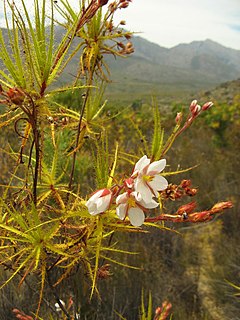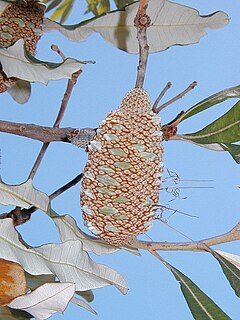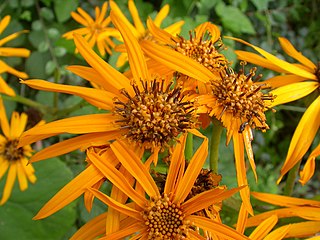
Lavandula is a genus of 47 known species of flowering plants in the mint family, Lamiaceae. It is native to the Old World and is found in Cape Verde and the Canary Islands, and from Europe across to northern and eastern Africa, the Mediterranean, southwest Asia to southeast India.

Roridula is a genus of evergreen, insect-trapping shrubs, with two species, of about 1⅓–2 m. It is the only genus in the family Roridulaceae. It has thin, woody, shyly branching, upright, initially brown, later grey stems, with lance- to awl-shaped leaves crowded at their tips. The star-symmetrical flowers consist from the outside in of five, green or reddish, free sepals, alternating with five white, pink or purple, free petals. Further to the middle and opposite the sepals are five stamens with the anthers initially kinked down. These suddenly flip up if the nectar-containing swelling at its base is being touched. The center of the flower is occupied by a superior ovary. The leaves and sepals carry many sticky tentacles of different sizes, that trap insects. Roridula does not break down the insect proteins, but bugs of the genus Pameridea prey on the trapped insects. These later deposit their feces on the leaves, which take up nutrients from the droppings. The species can be found in the Western Cape province of South Africa. They are commonly known as dewstick or fly bush in English and vlieëbos or vlieëbossie in Afrikaans.

Nepenthes hamata is a tropical pitcher plant endemic to Sulawesi, where it grows at elevations of 1400–2500 m above sea level.

Rhus dentata, the nana-berry (English), or nanabessie (Afrikaans), is a medium sized, deciduous tree, reaching a height of about 5 metres and a spread of 4 metres, and with a tendency to scramble through and over neighbouring trees. It occurs naturally in almost the whole of South Africa except the Western and Northern Cape Provinces. Its habitat varies from sea level to the highlands of the Drakensberg. It is frost-hardy and should be planted in full sun. The strongly aromatic leaves are usually conspicuously toothed, though sometimes they may be only slightly toothed. The tree produces small, creamy-white flowers in masses, developing into small, flattened drupes (5-6mm) which turn red or orange when ripe and brown when dry. The ripe fruits are eaten by birds, while the foliage is food for the larvae of the pepper tree moth Bombycomorpha bifascia.

Quercus dentata, also called Japanese emperor oak or daimyo oak is a species of oak native to East Asia. The name of the tree is often translated as "sweet oak" in English to distinguish it from Western varieties.

Banksia dentata, commonly known as the tropical banksia, is a species of tree in the genus Banksia. It occurs across northern Australia, southern New Guinea and the Aru Islands. Growing as a gnarled tree to 7 m (23 ft) high, it has large green leaves up to 22 cm (8.7 in) long with dentate (toothed) margins. The cylindrical yellow inflorescences, up to 13 cm (5.1 in) high, appear over the cooler months, attracting various species of honeyeaters, sunbirds, the sugar glider and a variety of insects. Flowers fall off the ageing spikes, which swell and develop follicles containing up to two viable seeds each.
The Field Elm cultivar Ulmus minor 'Albo-Dentata' first featured in the Baudriller nursery catalogue of 1880 as U. microphylla foliis albo-dentata. It was distributed by the Späth nursery of Berlin in the late 19th and early 20th century, as U. campestris microphylla fol. albo-dentatis.

Ligularia dentata is a species of flowering plant in the genus Ligularia and the family Asteraceae, native to China and Japan.
Parasiccia is a genus of moths in the subfamily Arctiinae.

Cyclemys is a genus of freshwater turtles, commonly referred to as Asian leaf turtles, from the family Geoemydidae. The genus occurs throughout Southeast and South Asia, and currently contains seven species.

Vagina dentata describes a folk tale in which a woman's vagina is said to contain teeth, with the associated implication that sexual intercourse might result in injury, emasculation, or castration for the man involved. The topic of "vagina dentata" may also cover a rare medical condition affecting the vagina, in which case it is more accurately termed a vaginal dermoid cyst.

Guinotia dentata, commonly known as cyrique, is a West Indian species of freshwater crab in the family Pseudothelphusidae. They have few predators. They are easily caught and thus are used locally as a food source.
Parasiccia chinensis is a moth of the subfamily Arctiinae. It was described by Franz Daniel in 1951. It is found in Zhejiang, China.

Parasiccia fuscipennis is a moth of the subfamily Arctiinae. It was described by George Hampson in 1914. It is found in Taiwan.
Parasiccia nebulosa is a moth of the subfamily Arctiinae. It was described by Wileman in 1914. It is found in Taiwan.
Parasiccia nocturna is a moth of the subfamily Arctiinae. It was described by George Hampson in 1900. It is found in Assam, India.
Parasiccia perirrorata is a moth of the subfamily Arctiinae. It was described by George Hampson in 1903. It is found in China.
Parasiccia punctilinea is a moth of the subfamily Arctiinae. It was described by Wileman in 1911. It is found in Taiwan.
Parasiccia shirakii is a moth of the subfamily Arctiinae. It was described by Shōnen Matsumura in 1930. It is found in Taiwan.

Lomatia dentata, commonly known as piñol or avellanillo, is a species of tree in the family Proteaceae.












